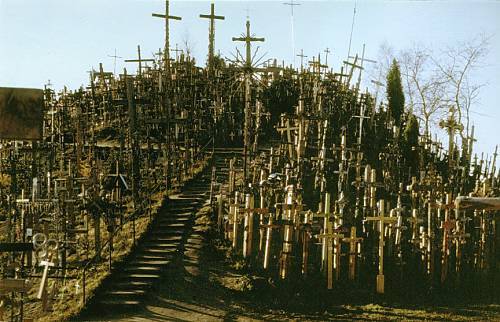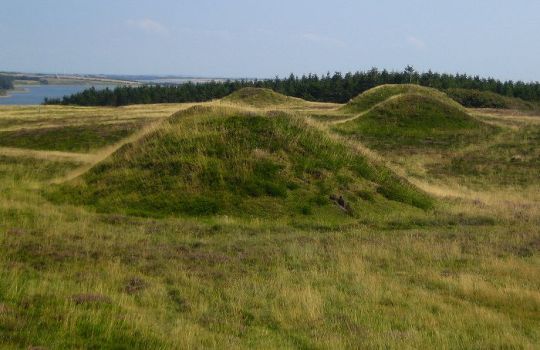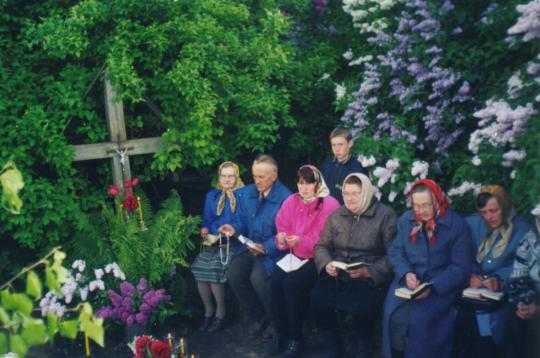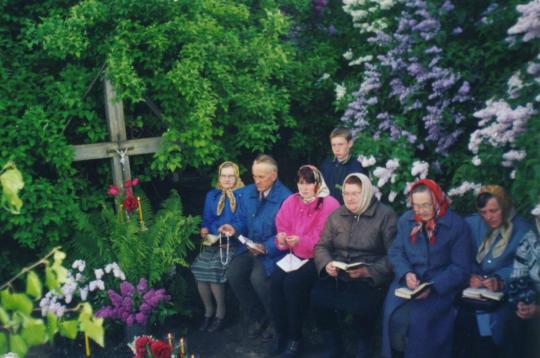#latviantraditions
Explore tagged Tumblr posts
Text
Catholic Cemetery Festival
At the Catholic cemetery festival, the Mass is celebrated at the center of the cemetery, during which those attending pray for the repose of the soul of the faithful departed. This religious activity is strictly regulated by the liturgical procedure of the Roman Catholic Church, therefore, divergences from this are not possible. The Mass is followed by a procession, which has the cross and the celun being carried at the front, followed by the priest and the most active singers and participants of the cemetery festival. The procession commences in the central part of the cemetery and continues around the inside perimeter of the fence. A special procession song is sung while walking. It contains a message about the end of the world, the perils of Judgment Day, the resurrection of the dead, the judgment of sinners, the repentance of sins, and the request to grant the deceased the bliss of Heaven. To follow the text of the songs, the participants in the procession use the Catholic prayer book in which the cemetery festival procession song is published in the section “Prayers for the Dead”. The procession stops at four places, usually at the corners of the cemetery at small altars, which people call galdini (little tables), and which have been set up specifically for the needs of the cemetery festival. At the first stopping place, they pray for the souls of departed priests, bishops, and other clergymen, at the second—for deceased fathers, mothers, and their ancestors, at the third—for brothers, sisters and other close relatives who have died, and at the fourth—for all the deceased who are interred in the cemeteries of this and other congregations. At the conclusion of the cemetery festival, the priest blesses children. Parents perceive this as being a protective measure against accidents or illnesses, even though the priest explained: “In praying for the dead, we remember the new generation, who will pray for us.” Newly erected tombstones are blessed as well if requested by relatives. Overall, the event lasts for about 1.5 h. This is the general structure of the event, characterizing the Catholic cemetery festival from year to year.
0 notes
Photo

Burial Mounds
Farmers were still buried into burial mounds into the 18th century, when the Great Plague felled many residents of Kurzeme (1710) and Vidzeme withstood the Russian pillaging during the Northern War, turning the land on both sides of the Daugava River into a huge cemetery field. It took two to three generations for people to recover somewhat. Only in 1773, when Vidzeme was under Russian rule, the Governor ordered the cemeteries to be marked off by a fence or surrounding rampart. Burials in the churches or churchyards was prohibited, which explains why Vidzeme developed vast cemeteries.
0 notes
Photo

Happy Easter! 🐣 #dyedeggs #naturallydyedeggs #onionskins #onionskindye #latviantraditions #happyeaster #handmadejewelry #flowerofparadise
#happyeaster#onionskindye#naturallydyedeggs#onionskins#flowerofparadise#handmadejewelry#dyedeggs#latviantraditions
1 note
·
View note
Text
Cemetery as a garden
Martin Luther’s idea that a cemetery must be a quiet place for aesthetic reflection, away from daily activity and one’s place of residence, was adopted by the leader of the Herrnhut Brethren congregation Nikolaus Ludwig von Zinzendorf. On his initiative, the Gottesacker (1730), one of the first garden cemeteries in Europe, was created in Herrnhut, and many Lutheran countries followed suit. A cemetery as a garden — this new interment culture flourished in Latvia in the first half of the 19th century. Against the background of industrialization and urbanization, “romantic visions of ideal landscapes and English gardening” came to the flore. This was in line with the Latvian traditional understanding of a cemetery as a resting place (atdusas vieta), since death was considered a sort of sleep (atdusa).
In the 19th century, when cemeteries in Latvia became similar to gardens/parks, concepts such as kapsētas svētki (graveyard festival), kapsētas dievkalpojums (graveyard service), kapusvētki (cemetery festival) and mironu svētki (festival of the dead) were mentioned in Latvian newspapers.
0 notes
Photo


With many new cemeteries opening in the late 18th century, Latvian peasants began to decorate graves with flowers in Vidzeme. In contrast, the decoration of crosses on graves with woodcarvings, bands and ribbons was practiced in the fishing villages of the western part of Latvia (Kurzeme). This can be considered an older traditional form for honoring the memory of the deceased. As the Herrnhutians tried to eliminate traditional forms of Latvian culture, we can assume that the Herrnhutians modified the traditional form of honoring the memory of the deceased in Vidzeme, attuning it to the ideas of the reformers.
0 notes
Text
Herrnhutian Brethren Community
The Herrnhutian movement has left a deep imprint on Latvian cultural life, as this developed self-confidence of Latvian peasants and prepared the ground for social changes. Several enduring cultural traditions began under the influence of the Herrnhutians. First, the choir singing tradition should be mentioned. At the Herrnhutian religious meetings, the laity sang easy-to-learn and sentimental Christian “folk songs” in their native language.
The Herrnhutians commenced their activities in Latvia at a time when the ancient traditions of honoring the memory of the deceased were dwindling, i.e., when a need for new traditions that would be understandable and acceptable to Latvian peasants arose. It is the Herrnhutians who are considered the founders of the grave tending tradition in Vidzeme.
0 notes
Text
In the Latvian Culture Canon, the grave tending tradition is mentioned among the 13 cultural phenomena. This tradition encompasses a special “socialization event”—kapusvētki, the cemetery festival. In Latvian, the term kapusvētki is a compound word made up of kapi—”cemetery” and svētki—”festival”. In explaining this phenomenon, its paradoxical nature is highlighted: “The concept itself contains a peculiar dualism—the cemetery, which is associated with sorrow, mourning, the loss of a loved one, and the festival, the main constituent of which is joy, which can have a certain touch of sacredness added to it.”
0 notes
Text
Balādīte
Our brother, with his horse,
Rode into the lord’s woods.
The lord’s men found him and agreed on a harsh punishment,
They took our brother’s horse.
They took our brother’s clothes,
They took our brother’s hat.
They released him, naked,
They sent him bound for home.
Our brother spilled white tears,
And the lord’s men returned his hat.
Our brother spilled salty tears,
And the lord’s men returned his clothes.
Our brother spilled hot tears,
And the lord’s men returned his horse.
Our brother spilled tears of blood,
Begging they return his flower.
Begging they return his flower,
That was pinned to his hat.
Fierce anger arose in the lord’s men,
They cut off our brother’s head.
Our brother’s head falls,
Crushing the flower that was pinned to his hat.
The flower which he had received this very morning,
From his betrothed.
0 notes
Photo

Burial Mounds
Farmers were still buried into burial mounds into the 18th century, when the Great Plague felled many residents of Kurzeme (1710) and Vidzeme withstood the Russian pillaging during the Northern War, turning the land on both sides of the Daugava River into a huge cemetery field. It took two to three generations for people to recover somewhat. Only in 1773, when Vidzeme was under Russian rule, the Governor ordered the cemeteries to be marked off by a fence or surrounding rampart. Burials in the churches or churchyards was prohibited, which explains why Vidzeme developed vast cemeteries.
0 notes
Photo

Officium for the dead
In Latgale, especially in the countryside, people still tend to die at home instead of the hospital or old people’s home. The dead person remains in the house until the funeral, the body being kept in some clean, cool place like the veranda or the granary. The funeral often being a few days off, the living are preparing for the mourning ceremony, including performing the Officium in the evenings. The members of the household, relatives and friends of the deceased come together and conduct the Officium prayer. The table, usually an ordinary rectangular table in the living room, aroung which the singers sit, is covered by a white linen table cloth. The performance takes place at the house also a year after the person’s death or if it is an annual memorial service for all the dead members of the family. Since, in common prayer, the images of the dead are recalled in the consciousness of the living, it also serves as a meeting between the living and the dead.
The cemetery ritual is similar. In its essence, the Officium is one of the most powerful prayers for the dead in the pyres of Purgatory. The people of Latgale are well aware of the dogmatic context of the Officium and consider its performance a valuable opportunity to express their love and support for their loved ones even after their death.
In Soviet times, the practice of the Officium for the Dead was not particularly suppressed. However, the fate of the tradition was affected because the cycle of inheritance was interrupted: children and young people no longer participated. Nowadays, the performers are usually old people, which means that the existence of the tradition is on the brink of extinction.
0 notes
Photo

Dzīduošona pi krusta
The May open air services by the roadside or village crosses is a new tradition, but the possibility that it may be indirectly related to the old outdoor singing traditions cannot be excluded. They are held without the presence and guidance of priests. The leader of the service comes from the midst of the participants. Usually it is an older woman who knew the structure of the ritual and the melodies and could start every one at a suitable pitch. Songs devoted to Mary are at the center of the May service. They tell the story of Mary’s life, suffering, and her sacrifice for humanity.
0 notes
Photo

Officium for the dead
In Latgale, especially in the countryside, people still tend to die at home instead of the hospital or old people’s home. The dead person remains in the house until the funeral, the body being kept in some clean, cool place like the veranda or the granary. The funeral often being a few days off, the living are preparing for the mourning ceremony, including performing the Officium in the evenings. The members of the household, relatives and friends of the deceased come together and conduct the Officium prayer. The table, usually an ordinary rectangular table in the living room, aroung which the singers sit, is covered by a white linen table cloth. The performance takes place at the house also a year after the person’s death or if it is an annual memorial service for all the dead members of the family. Since, in common prayer, the images of the dead are recalled in the consciousness of the living, it also serves as a meeting between the living and the dead.
The cemetery ritual is similar. In its essence, the Officium is one of the most powerful prayers for the dead in the pyres of Purgatory. The people of Latgale are well aware of the dogmatic context of the Officium and consider its performance a valuable opportunity to express their love and support for their loved ones even after their death.
In Soviet times, the practice of the Officium for the Dead was not particularly suppressed. However, the fate of the tradition was affected because the cycle of inheritance was interrupted: children and young people no longer participated. Nowadays, the performers are usually old people, which means that the existence of the tradition is on the brink of extinction.
0 notes
Photo


Dzīduošona pi krusta
The May open air services by the roadside or village crosses is a new tradition, but the possibility that it may be indirectly related to the old outdoor singing traditions cannot be excluded. They are held without the presence and guidance of priests. The leader of the service comes from the midst of the participants. Usually it is an older woman who knew the structure of the ritual and the melodies and could start every one at a suitable pitch. Songs devoted to Mary are at the center of the May service. They tell the story of Mary’s life, suffering, and her sacrifice for humanity.
0 notes
Photo

Kapusvētki: The Latvian Cemetery Festival
People used to bury their dead relatives next to their house, and for sanitary reasons, they built cemeteries. Being around the deceased was important and people would miss church to go to the cemetery, so the church decided to make a festival. But in the 1940s, the state didn’t like this celebration as it was linked to the church, and the festival became also a way to resist the sovietization of Latvia.
Before the festival, the gravestones would be cleaned and flowers would be planted / taken care of to make everything look as beautiful as possible.
During the festival, there is singing and preaching.
After the festival, there is a dinner party.
Things to say when arriving at the festival:
“It is so beautiful here.”
“It is so peaceful here.”
“It is so green here.”
Things to avoid doing at the festival:
Not washing your hands when leaving the cemetery (insult to the gods).
0 notes
Photo

Kapusvētki: The Latvian Cemetery Festival
People used to bury their dead relatives next to their house, and for sanitary reasons, they built cemeteries. Being around the deceased was important and people would miss church to go to the cemetery, so the church decided to make a festival. But in the 1940s, the state didn’t like this celebration as it was linked to the church, and the festival became also a way to resist the sovietization of Latvia.
Before the festival, the gravestones would be cleaned and flowers would be planted / taken care of to make everything look as beautiful as possible.
During the festival, there is singing and preaching.
After the festival, there is a dinner party.
Things to say when arriving at the festival:
“It is so beautiful here.”
“It is so peaceful here.”
“It is so green here.”
Things to avoid doing at the festival:
Not washing your hands when leaving the cemetery (insult to the gods).
0 notes
Photo

Freshly made Latvian midsummer celebration treat - caraway cheese. Maybe not perfect but I and my dog we love it 🐶 🧀 😋 If you feel like reading a funny article about midsummer celebration in Baltics, google "13 facts you should know before heading to the Baltics for midsummer". Let me know what you think! 😂 💚💚💚 #cheese #handmadecheese #latvian #latvianfood #latviantraditions #pagan #pagantraditions #summersolstice #summersolstice2019 #midsummertradition #naturelover #naturelovers #crazyplantlady #plantlady #planthoarder #imaplanthoarder #ihavethisthingwithplants #plantsarelife #plantsaremagic #plantsarefriends #plantsmakepeoplehappy #plantsmakemehappy #food #foodporn #traditionalfood #traditionalfoods #beautifultradition #proudlylatvian https://www.instagram.com/p/By_UvlbBzkB/?igshid=19fkp869ajkfz
#cheese#handmadecheese#latvian#latvianfood#latviantraditions#pagan#pagantraditions#summersolstice#summersolstice2019#midsummertradition#naturelover#naturelovers#crazyplantlady#plantlady#planthoarder#imaplanthoarder#ihavethisthingwithplants#plantsarelife#plantsaremagic#plantsarefriends#plantsmakepeoplehappy#plantsmakemehappy#food#foodporn#traditionalfood#traditionalfoods#beautifultradition#proudlylatvian
0 notes